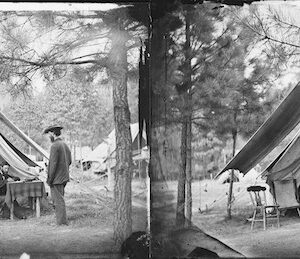Tag: Myer (Albert J.)
 Wikipedia sys: Albert James Myer (September 20, 1828 – August 24, 1880) was a surgeon and United States Army general. He is known as the father of the U.S. Army Signal Corps, as its first chief signal officer just prior to the American Civil War, the inventor of wig-wag signaling (or aerial telegraphy), and also as the father of the U.S. Weather Bureau.
Wikipedia sys: Albert James Myer (September 20, 1828 – August 24, 1880) was a surgeon and United States Army general. He is known as the father of the U.S. Army Signal Corps, as its first chief signal officer just prior to the American Civil War, the inventor of wig-wag signaling (or aerial telegraphy), and also as the father of the U.S. Weather Bureau.
…The June 21, 1860, letter from the War Department that ordered Myer to organize and command the new U.S. Army Signal Corps provided little of substance. It authorized $2000 for equipment and a promotion for Myer to major, effective June 27. Myer was faced with the responsibility of recruiting subordinates who could be detailed from elsewhere in the Army. The Signal Corps would not commence as an official Army organization until March 3, 1863, at which time Myer was promoted to colonel. Between these two dates, Myer served first under Maj. Gen. Benjamin Butler at Fort Monroe, Virginia, where he established a camp of instruction, and then as the chief signal officer for Maj. Gen. George B. McClellan’s Army of the Potomac in its campaigns from the Peninsula Campaign to the Battle of Antietam. During this period Myer was awarded a brevet promotion to lieutenant colonel in the regular army for his actions at Hanover Court House, and to brevet colonel for Malvern Hill.
Ironically, the first use in combat of Myer’s signaling system was by Confederate Captain Edward Porter Alexander at the First Battle of Bull Run. Alexander had been a subordinate of Myer’s and assisted in the New York field trials.
In addition to his aerial signaling, Myer recognized the need for electrical telegraphy in field communications. He introduced a field telegraph train of wagons to support a device called the Beardslee telegraph, which used a dial instead of a key tapping Morse code, developed to require less training for its operators.
Myer’s Signal Corps was actually a separate entity from the Military Telegraph Service, a War Department bureau staffed primarily by civilian telegraph operators. He had numerous organizational disputes with the assistant secretary of war for this function, attempting on several occasions to take control of all telegraphic operations. When he proposed to remove the less than dependable Beardslee device and recruit trained telegraphers into the Signal Corps, Secretary of War Edwin M. Stanton removed him from his post as chief signal officer on November 15, 1863, and reassigned him out of Washington, D.C., effectively exiling him.
While conducting routine reconnaissance of the Mississippi River from Cairo, Illinois, to Memphis, Tennessee, Myer wrote the Manual of Signals for the United States Army and Navy. In June 1864, he was appointed by Maj. Gen. E.R.S. Canby to be the signal officer of the Military Division of West Mississippi. Under Canby, Myer added a new duty to the tasks of the Signal Corps by working out a system for interrogating deserters and refugees who came into the Union lines. He also developed a coding system for transmitting routine messages between land and sea forces. He organized communications plans for the operations in the Mobile area and participated, with U.S. Navy officers, in the surrender of Fort Gaines. He served as signal officer for the Department of the Gulf from August 1864 to 1865.
While he was preparing for the Mobile campaign, Myer received the disturbing news that his appointment as colonel and chief signal officer, which had been made before his dismissal in 1863, had not been confirmed by the Senate and was revoked, thus returning him to his permanent rank of major. Through early 1865, Myer employed lawyers and political connections to attempt to correct what he perceived as an injustice. On July 28, 1866, reacting to the influence of Lt. Gen. Ulysses S. Grant and President Andrew Johnson, Congress reorganized the Signal Corps and, with the permanent rank of colonel, Myer again became chief signal officer. He was particularly gratified when word of this victory came on October 30, 1866, as his old nemesis, Edwin Stanton, had to inform him of his reinstatement. He was not confirmed in the position until February 1867 and was not ordered to active duty until August 1867. His new duties included control of the telegraph service, resolving the dispute that had removed him from his position.
On December 3, 1867, President Andrew Johnson nominated Myer for appointment to the grade of brevet brigadier general in the Regular Army (United States), to rank from March 13, 1865, and the United States Senate confirmed the appointment on February 14, 1868. Myer received the brevet grade in honor of his formation of the Signal Corps. His commission as brigadier general in the regular Army came on June 16, 1880, two months before his death. As an Army officer, Myer was nicknamed “Old Probabilities” by his subordinates.
Showing all 5 resultsSorted by latest
-

Image ID: ARRK
$5.99 -

Image ID: AQTE
$6.99 -

Image ID: ARBQ
$6.99 -

Image ID: ARBR
$6.99 -

Image ID: AJSL
$5.99 – $6.99 This product has multiple variants. The options may be chosen on the product page